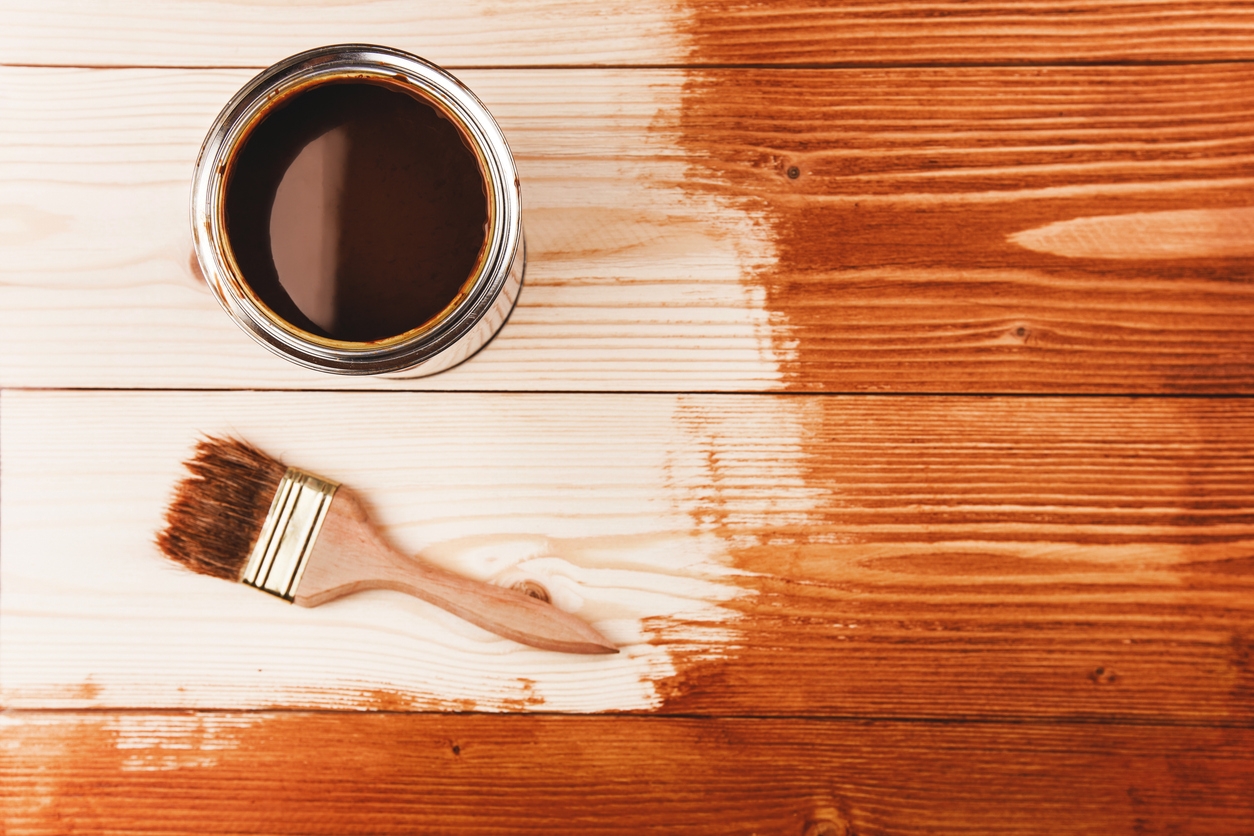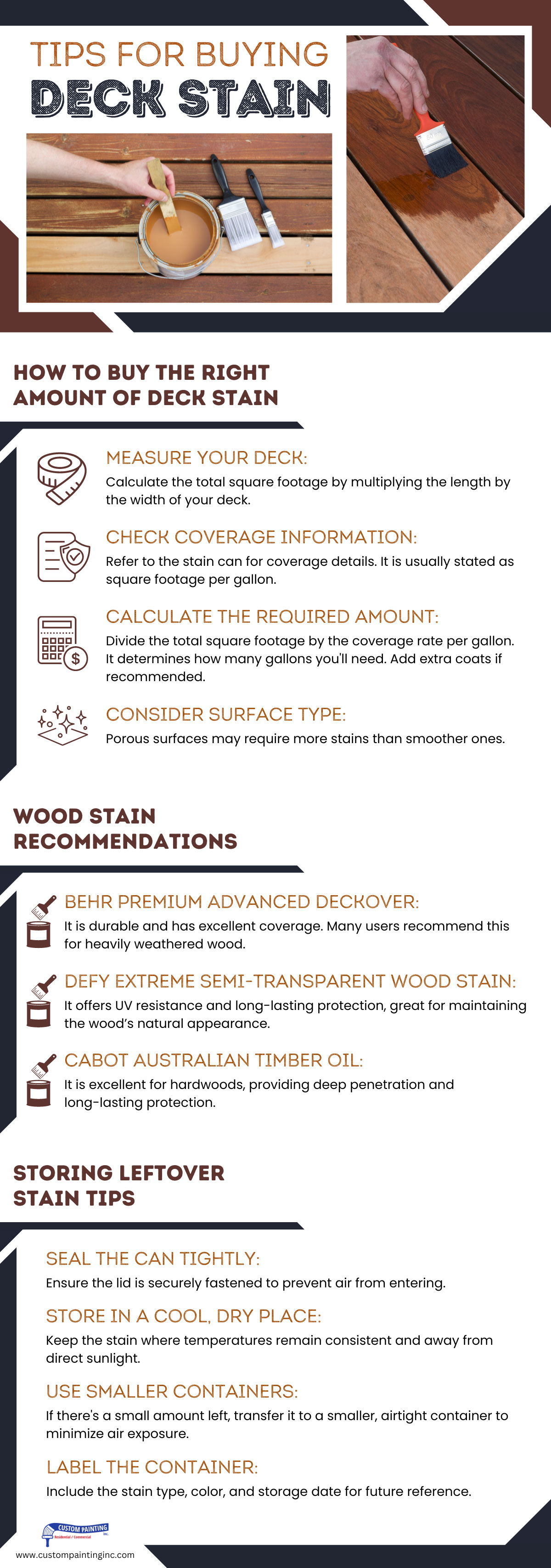A deck on your residential property has many benefits, including increased curb appeal and resale value. Staining your deck to keep it looking fantastic is a good idea.
Staining a deck is essential for both protection and aesthetic enhancement. It helps shield the wood from weather damage, UV rays, and moisture, extending the deck’s lifespan. Staining enhances the wood’s natural beauty and color. It provides the deck with a fresh and attractive appearance, complementing your outdoor space’s overall look.
Understanding deck stain
Know the types of stains and the factors affecting their application. It will help you choose the best product and achieve the best results for your deck.
Deck stain types
1. Transparent stains
Characteristics: They provide minimal color, enhancing the wood’s natural grain and color. They offer protection against UV rays and weather.
Best for: Newer wood or wood with a beautiful natural grain you want to showcase.
2. Semi-transparent stains
Characteristics: They partially add color while allowing the wood grain and texture to show through. They offer better UV protection and durability than transparent stains.
Best for: Older decks where you want to add color but still see the wood grain.
3. Solid stains
Characteristics: Solid stains provide the most color and opaque coverage, hiding the wood grain entirely. They also offer the best protection against UV rays and weather.
Best for: Aged or weathered and worn decks, providing a uniform appearance.
Factors affecting stain absorption and coverage
1. Wood type and age
- Softwoods versus hardwoods – Softwoods (like pine or cedar) absorb stains more readily than hardwoods (like oak or mahogany).
- New versus weathered wood – New wood may have mill glaze, reducing absorption, while older, weathered wood absorbs more stain.
2. Wood moisture content
- Dry wood – Absorbs stain more evenly and effectively.
- Damp wood – Can repel stain, leading to uneven coverage and poor absorption.
3. Preparation and cleaning
- Clean surface – A well-cleaned and sanded surface ensures better absorption.
- Dirt, mold, or old finish – These can block the stain from penetrating the wood.
4. Application method
- Brush, roller, or sprayer – The application method can affect how evenly the stain is applied and absorbed.
- Number of coats – Multiple thin coats can enhance absorption and coverage compared to one thick coat.
5. Weather conditions
- Temperature – Extreme heat or cold can affect drying times and absorption rates.
- Humidity – High humidity can slow drying time and affect the final finish.
6. Deck stain quality
- Pigment and binder content—Higher-quality stains have better pigments and binders. They provide more consistent absorption and longer-lasting coverage.
Preparing to measure your deck
Having the correct materials and following instructions ensures your deck is properly cleaned and prepared for staining.
Tools and materials needed
- Measuring tape
- Calculator
- Notepad and pen
- Broom or brush
- Power washer or garden hose with a spray nozzle
- Deck cleaner solution
- Scrub brush
- Safety gloves
- Eye protection
- Sandpaper or a sanding tool (if needed)
- Stain and applicator (brush, roller, or stain pad)
- Drop cloth or plastic sheeting
- Painter’s tape
Cleaning and preparing your deck
1. Clear the deck
- Remove all furniture, plants, and other items from the deck.
2. Sweep the deck
- Use a broom or brush to sweep loose debris, leaves, and dirt.
3. Wash the deck
- Use a power washer or garden hose with a spray nozzle to thoroughly wet the deck.
- Apply a deck cleaner solution according to the manufacturer’s instructions.
- Scrub the deck to remove dirt, mold, and mildew.
4. Rinse the deck
- Rinse the deck thoroughly with clean water to remove the cleaning solution.
- Let the deck fully dry. Drying takes 24-48 hours, depending on weather conditions.
5. Inspect and sand (if needed)
- Inspect the deck for any rough spots or splinters.
- Sand any rough areas with sandpaper or a sanding tool to create a smooth surface.
6. Protect surrounding areas
- Cover nearby plants, furniture, and surfaces with a drop cloth or plastic sheeting.
- Use painter’s tape to protect edges and areas you don’t want to stain.
Calculating deck size
Measuring the deck area and calculating the square footage can help you determine how much wood stain you need.
1. Measure the deck area
- Length x width – Use a tape measure to find the length and width of the deck. Multiply these two measurements to get the area in square feet.
2. Include additional features
- Railings – Measure the length of the railings and add the area they cover if they extend over the deck.
- Stairs – Measure the length and width of each step, then multiply to get the area of one step. Multiply by the number of steps.
- Benches – Measure the length and width of the benches, then multiply to find their area.
3. Calculate square footage
- Basic formula – Square footage = Length x Width
- Additional features – Add the area of railings, stairs, and benches to the basic deck area.
Example:
- Deck: 20 feet long and 15 feet wide.
- Basic area: 20 ft x 15 ft = 300 sq ft
- Stairs: 3 steps, each 4 feet wide and 1 foot deep.
- Area of steps: 3 x (4ft x 1 ft) = 12 sq ft
- Total area: 300 sq ft + 12 sq ft = 312 sq ft
Add the areas of other features as applicable to get the total square footage.
Estimating stain needs based on coverage
Understanding the manufacturer’s coverage specifications
The manufacturer’s coverage specifications detail how much area a wood stain can cover. It is usually expressed in square feet per gallon. These specifications account for the stain’s viscosity, the type of surface where you’ll apply the stain, and the recommended number of coats. Follow these guidelines to ensure proper coverage and optimal results.
How different types of wood might absorb stains differently
Different types of wood have varying porosities and grain patterns, affecting how they absorb stains. For example:
- Softwoods (like pine) often absorb stain more unevenly, which can result in a blotchy appearance without proper preparation.
- Hardwoods (like oak) absorb stains more evenly due to their denser structure.
- Porous woods (like fir) can absorb more stain, leading to a darker finish.
Understanding these differences helps you choose the right type of stain and application method to achieve a consistent finish.
Case examples: Calculating stain for different-sized decks
Use the manufacturer’s coverage specifications and the deck’s total surface area. They help you calculate how much stain you need for your deck.
1. Determine the deck area
- Measure the length and width of the deck to calculate its total square footage. For example, a 20-ft by 15-ft deck has an area of 300 sq ft.
2. Check coverage specifications
- If a gallon of stain covers 200 sq ft, divide the total deck area by the coverage per gallon.
3. Calculate the quantity needed
- For a 300 sq ft deck: 300 sq ft / 200 sq ft per gallon = 1.5 gallons.
- Add 10-20% to account for wood porosity and application method inconsistencies. For 300 sq ft, you might need around 1.8 gallons.
You can adjust these steps based on your deck’s size and the wood stain’s coverage rate.
Considering multiple coats and touch-ups
The factors below will help you ensure a uniform and durable finish for your deck.
Deciding on the number of coats
- Wood type and condition – Softer, more porous wood may require more coats. In contrast, denser wood might need fewer.
- Desired color intensity – More coats result in a deeper, richer color.
- Stain type – Some stains are designed for a single coat, while others may require multiple.
- Manufacturer’s recommendations – Follow the instructions on the stain product for the best results.
Factoring in extra stain for touch-ups and problem areas
- Surface preparation – Rough or damaged areas might absorb more stain, requiring extra coats.
- Future touch-ups – Keep some extra stain for maintenance, especially for high-traffic or exposed areas.
- Application consistency – Ensure you have enough stain to apply evenly across the entire deck. It accounts for overlaps and finishing touches.
Tips for buying deck stain
How to buy the right amount of deck stain
- Measure your deck – Calculate the total square footage by multiplying the length by the width of your deck.
- Check coverage information – Refer to the stain can for coverage details. It is usually stated as square footage per gallon.
- Calculate the required amount – Divide the total square footage by the coverage rate per gallon. It determines how many gallons you’ll need. Add extra coats if recommended.
- Consider surface type – Porous surfaces may require more stains than smoother ones.
Wood stain recommendations
- Behr Premium Advanced DeckOver – It is durable and has excellent coverage. Many users recommend this for heavily weathered wood.
- DEFY Extreme Semi-Transparent Wood Stain – It offers UV resistance and long-lasting protection, great for maintaining the wood’s natural appearance.
- Cabot Australian Timber Oil – It is excellent for hardwoods, providing deep penetration and long-lasting protection.
Storing leftover stain tips
- Seal the can tightly – Ensure the lid is securely fastened to prevent air from entering.
- Store in a cool, dry place – Keep the stain where temperatures remain consistent and away from direct sunlight.
- Use smaller containers – If there’s a small amount left, transfer it to a smaller, airtight container to minimize air exposure.
- Label the container – Include the stain type, color, and storage date for future reference.
Conclusion
Accurately determining the amount of deck stain helps avoid over-purchasing or under-purchasing. Measure your deck and calculate its size, estimate stain needs based on coverage, and buy the correct type and amount of stain needed. Following these steps ensures adequate stain coverage for your deck. Proper preparation ensures the wood stain adheres well and provides a durable and even finish. It enhances the deck’s appearance and longevity.
Or hire a professional painter to stain your deck. This will help you save time and trouble while guaranteeing your deck a beautiful and long-lasting finish. Call Custom Painting, Inc. at 925-686-0903 or contact us online for a free job quote.




